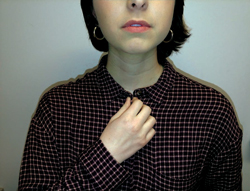I became interested in dressing androgynously (between the typical male and female fashion) more out of mere comfort than from establishing an identity.
It started when I was 11 years old, making my mom buy me t-shirt after t-shirt from Hot Topic. These shirts were usually labeled as men’s smalls, printed with the art of a band I listened to at the time, and they were always far too big on me. I complimented my look with colored jeans that were never too tight or too loose, and a pair of plain Vans.
At the time, the fashion for girls were neon-colored tank tops, large hoop earrings, and skinny blue jeans, finished off with the Juicy Couture faux-fur lined zipper hoodie. When I looked in the mirror in the mornings, there was no way my figure would vibe well with those pieces.
Several years down the line, after I moved away from my Hot Topic phase, the clothes that I donned became a little more than just for the sake comfort. It manifested in an identity I was able to craft for myself, and with total control.
Being able to dress a certain way became a safe haven of self-expression wherein I was able to pinpoint exact moments in my life through my clothing.
For instance, I have this pair of striped socks that I fell in love with while I was in Vermont with two of my best friends. It was this small shop tucked away on the main streets of Brattleboro and the owner and I talked endlessly about the origins of the printmaking factory in the center of town.
I can still remember the scent of the store, the coldness and wetness of my feet, the coffee shop where I enjoyed an Apple Cinnamon Cider donut with a green tea and the downtown filled with the beautiful, dirt-crusted snow
While the importance of feeling comfortable in one’s dress certainly stresses creativity or fitting in, it also helps debunk traditional gender stereotypes, allowing ourselves to place our bodies in a context outside of the various privileges we are exposed to every day.
“For example, someone who always wears pants doesn’t necessarily have to always be masculine versus if someone always wears skirts or dresses doesn’t have to always have to be feminine,” said Taffy Lashley, a sophomore communication student. “Our identities are a spectrum and it should not be defined by the clothes a person wears.”
“Perpetuating these stereotypes in clothing directly affects how we perceive men and women in a society in which they are already so divided in terms of privilege,” aid Corinne Cavallo, an adjunct professor of English.
“Women are essentially slowed down due to their maintenance to clothing while men are restricted to self-expression,” she continued.
“It became my tool of expression in a world where it felt like anyone younger than thirty did not have a voice in society,” she said.
“Personally speaking, the clothes that I wear has become a huge part of my identity in general,” said Jesse Lee, a sophomore social work student. He finds that simply wearing a band t-shirt can spark conservation and bring for the strongest bonds that people are able to have with another.
Instead of bringing people together, strict gender stereotypes in clothing remains as an effort to break us apart.
Androgyny is a choice I chose, originally as a way of comfort, but now has become a lifestyle of crafting a piece of myself in something as simple as picking what I choose to wear in the morning.
I don’t feel that I materialize shopping as always having the newest, most popular brand name or the most in-fashion piece, but rather, the act itself lends me to build a collection of tangible memories which attach themselves onto my body.
They’re all unique and different rather than an expensive Nike hoodie at retail price that I can buy from the local mall because they’re secrets shared with my friends and I; the memory is the metaphor in which it presents itself.
PHOTO TAKEN by Alexandria Afanador




